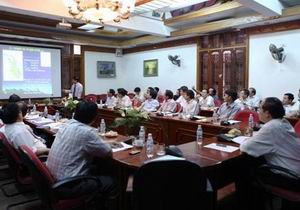Gov’t leader reviews climate change response
VGP – Deputy PM Nguyễn Thiện Nhân on Thursday afternoon met with representatives of ministries and agencies to review inundation and impacts of climate change in Việt Nam over the past time and in the time to come.
|
|
|
A meeting on climate change is convened in Hà Nội on September 24, 2009 - Photo: VGP |
It is forecast that by 2070, the stream flow of the Mekong River during flood months will increase by 41% in the upper section and by 19% in the lower section. Meanwhile, in dry season, it can decrease by 24% and 29% in these areas respectively. This means that floods in rainy season and droughts in dry season will become more severe.
These are direct consequences of climate change which is a big challenge for Việt Nam’s sustainable development.
The Ministry of Agriculture and Rural Development reported that, in the last decade, the number of storms hitting the coastal areas has gone up by 0.4 times. According to forecast of the Ministry of Natural Resources and Environment, by 2010, the annual average temperature will be 2.30C higher than the period of 1980-1999. And the country’s rainfall increases by about 5% against the same ten-year period.
Due to the changes of rain regime and the process of urbanization and industrialization, the water demand has sharply increased. Clean water sources will become scarce and about 8.4 million people in Việt Nam face the shortage of fresh water by 2050.
If the sea level goes up 30 cm by 2050 and 75 cm by 2100, about 20% of the country’s area will be under frequent inundation and 20 million people are affected.
Việt Nam has taken part in the international convention of climate change, so that it is possible to call for international cooperation in mitigating climate change consequences, especially on irrigation.
Deputy Minister of Planning and Investment Nguyễn Thế Phương suggested the Government design financial mechanisms for national programs on climate change.
Representatives from many ministries and agencies stressed the necessity to build a data center of water resource as well as design a best scenario with specific plans to cope with climate change.
Addressing the meeting, Deputy PM Nguyễn Thiện Nhân asked ministries and agencies to focus on five assignments: (i) Nurturing staff for the irrigation sector; (ii) promoting cooperation and technological transfer with foreign partners; (iii) raising funds for activities to cope with climate change; (iv) calling for foreign supports; and (v) checking regional planning schemes and working out specific irrigation solutions on response to climate change.


